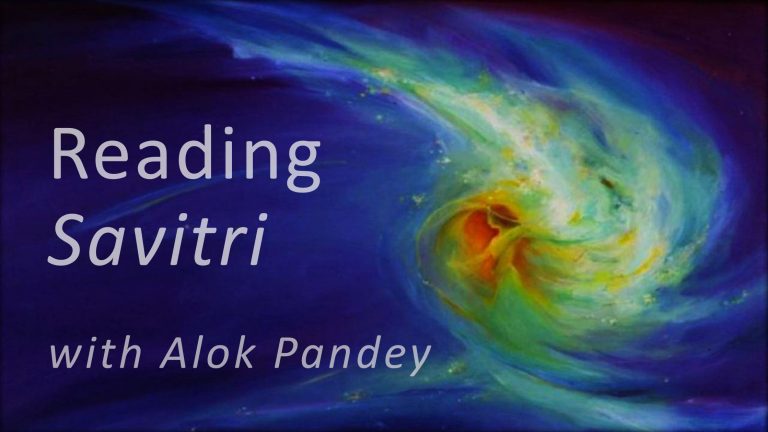I
The main obstacle that stands in the way of accepting the straightforward meaning of the Isha Upanishad and rightly understanding its inner truth about the Brahman, the Self and the Divine, is Mayavada, Illusionism, preached by Shankaracharya and the commentary he wrote on this Upanishad. The one-pointed drive towards withdrawal that is Illusionism and the much-praised inaction of the Sannyasi are completely at variance with the Isha Upanishad. If the meaning of the slokas is strained and tortured to give an opposite sense, the solution of this quarrel becomes impossible. The Upanishad in which it is written: ‘Doing verily works in this world one should wish to live a hundred years’, and again: ‘Action cleaves not to a man’ — the Upanishad which proclaims with courage: ‘Into a blind darkness they enter who follow after the Ignorance, they as if into a greater darkness who devote themselves to the Knowledge alone’; and again says: ‘By the Birth one enjoys Immortality’, how can that Upanishad be reconciled with Mayavada, Illusionism and the path of withdrawal? A highly erudite person, who was possibly the chief sponsor of Monism in South India after Shankara, expunged it from the list of the twelve Upanishads and installed the Nrisimhatapini in its place. Shankaracharya was not so daring as to alter the prevailing canon. The Upanishad was a ‘Sruti’ (heard scripture), and Illusionism was a subject for inquiry in the ‘Sruti’ and as such, he assumed, the meaning of the ‘Sruti’ could not but be favourable to real Illusionism.
If jagat (in īśa vāsyamidam sarvam yat kīñca jagatyām jagat) meant the earth, then the meaning would be: ‘all that is moving on the earth in motion’, that is to say, all men, animals, insects, birds, torrents, and rivers, etc. This meaning is absurd. In the language of the Upanishads, the word sarvamidam signifies all the visible objects of the universe, not of the earth. Therefore we must understand by the word jagati the Shakti in movement manifested as the universe and by the word jagat all that is a movement of motion of the Prakriti whether present as a living being or as matter. The contradiction lies between these two: the Ishwara and all that is in the universe. Unlike the Ishwara who is immobile, the Prakriti, the Shakti, is in movement always engaged in work and world-wide motion; all that exists in the universe is also a small universe in movement which is always, at each instant, the meeting-place of creation, preservation and destruction, the restless and perishable, the opposite of the immutable. The eternal contradiction does not become evident if we place on one side the Ishwara and on the other, the earth and all that is in movement on the earth. This Upanishad opens with the eternal contradiction observed by everybody which puts the immutable Ishwara on one side and on the other the restless Prakriti and all that she possesses in the universe created by her, all ephemeral objects.
The whole Upanishad is constructed upon this contradiction and its resolution. Later on, the author of the Upanishad, while discussing the nature of the Ishwara and the nature of the universe brings up thrice the same problem but each time with a different approach. First when he talks about the Brahman, he demonstrates the opposition of the Purusha and the Prakriti and in these few words, ‘anejad’ (unmoving) and manaso javīyaḥ… tad ejati tannaijati (swifter than Mind, That the Gods reach not, for It progresses ever in front. That, standing, passes beyond others as they run. In that the Master of Life established the Waters. That moves and moves not) he explains that both are Brahman: the Purusha is Brahman, the Prakriti and the universe which is her outward form are also Brahman. Again, while speaking of the Atman, he explains the opposition between the Ishwara and everything concerning the universe. The Atman is the Ishwara, the Purusha…
If it is squeezed, then most surely the true hidden meaning, that is to say, the doctrine of Illusionism, will be forced out because of the pain: this was the conclusion that overpowered Shankaracharya, and he wrote a commentary on the Isha Upanishad.
Let us hear on the one hand what the commentary of Shankara says, and on the other what the Upanishad has truly to say. The author of the Upanishad right in the beginning compares the truth of the Ishwara with the Truth of the universe and indicates their fundamental relation.
‘īśa vāsyamidam sarvam yat kīñca jagatyām jagat’, ‘All this is for habitation by the Lord, whatsoever is jagat within jagati or individual universe in movement’ — the still all-pervading controller Purusha and the Prakriti in motion — the Ishwara and the Shakti. As the name of Ishwara has been given to the Immutable, we have to understand that the true relation between the Purusha and Prakriti is this: ‘jagat’ depends on the Ishwara, is governed by Him and accomplishes all work by His will. This Purusha is not only a witness and giver of sanction but Ishwara, the knower, the director of action; the Prakriti is not the controller of action but she works out the destiny, the mistress but dependent on the master, the obedient active Shakti of the Purusha.
Then we observe that ‘jagati’ is not simply the Shakti in movement, not simply the principle which is the cause of the universe; she is also present as the universe itself. The ordinary meaning of the word ‘jagati’ is ‘the earth’, but it cannot apply here. By combining these two words jagatyam jagat the author of the Upanishad has hinted that the root-meaning of these two words must not be neglected. To emphasise it has been his aim.
(Vividha Rachana, 1955)



About Savitri | B1C1-10 The Response of Earth (p.5)